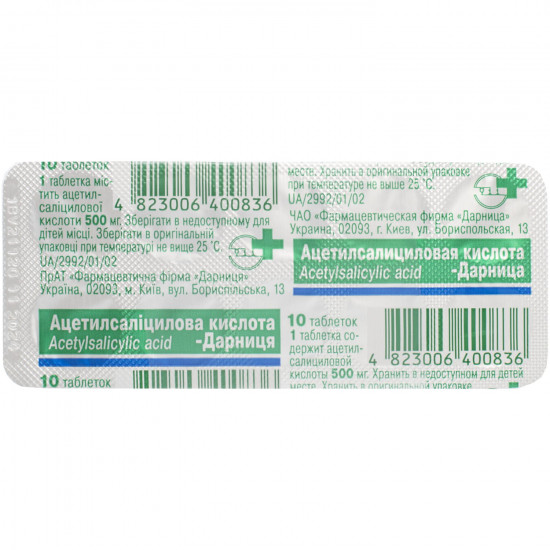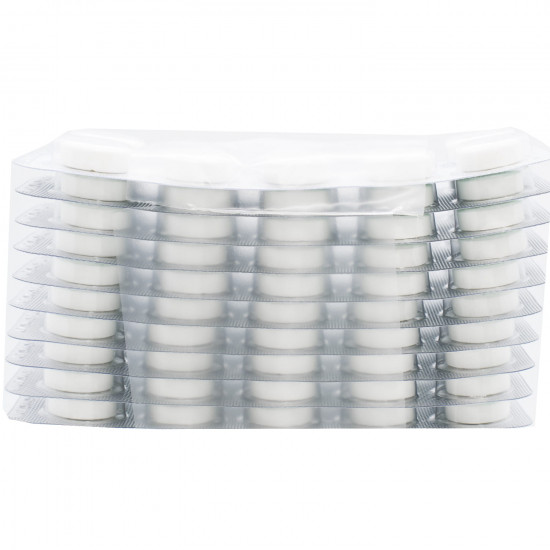



- Stock: In Stock
- Model: 182021
0% Customers recommend this product
-
5 Awesome0%
-
4 Great0%
-
3 Average0%
-
2 Bad0%
-
1 Poor0%
Reviews Over Acetilsalicylic to - that (aspirin) of the tab. of 500 mg No. 10
- (0)
Total Reviews (0)
click here write review to add review for this product.
Report this review.
Description
Pharmacological properties
Pharmacodynamics. acetylsalicylic acid — npvp, derivative salicylate. the main mechanism of effect of acetylsalicylic acid is the enzyme inactivation tsog owing to what the products of mediators of inflammation decrease: prostaglandins, prostacyclin and thromboxane. reduction of synthesis of prostaglandins leads to decrease in their influence on the centers of thermal control that promotes decrease in the body temperature increased owing to inflammation. reduces the sensibilizing influence of prostaglandins on nerve terminations, sensitive to pain, reduces their sensitivity to pain mediators. irreversible oppression of synthesis of thromboxane a2 in thrombocytes causes antiagregantny effect of acetylsalicylic acid.
Pharmacodynamics of acetylsalicylic acid depends on a daily dose:
low doses — 30–325 mg — cause slowing down of aggregation of thrombocytes;
average doses — 1.5-2 g — have analgeziruyushchy and febrifugal effect;
tohigh doses — 4 g — render anti-inflammatory effect.
In a dose of 4 g acetylsalicylic acid delays removal of uric acid.
Pharmacokinetics. At intake it is almost completely absorbed in a GIT. Time of achievement of the C max in blood plasma (T max ) is 10–20 min., the T max general salicylate which is formed as a result of metabolism makes 0.3-2 h. Extent of linking with proteins of blood plasma makes 49–70%. For 50% it is metabolized at primary passing through a liver. The glycylconjugate of salicylic acid is formed. It is brought out of an organism through kidneys in the form of metabolites. The t ½ makes 20 min. T ½ for salicylic acid — about 2 h. Gets into breast milk, synovial fluid, liquor.
Indication
For symptomatic treatment of a headache, a toothache; the sore throat caused by cold; algodismenore; muscle and joints pains; dorsodynias; the moderate pain caused by arthritis.
In cold or acute respiratory diseases for symptomatic reduction of severity of pain and fever.
Use
Acetylsalicylic acid-darnitsa is accepted inside after a meal, washing down with enough liquid.
cannot longer apply Acetylsalicylic acid-Darnitsa 3–5 days without consultation of the doctor.
Adults and children are aged more senior than 15 years. 500–1000 mg once. Repeated use is possible in 4–8 h. The maximum daily dose should not exceed 4 g
Prevention. For patients with the accompanying abnormal liver functions or kidneys it is necessary to lower a dose of medicament or to increase an interval between receptions.
Contraindication
Hypersensitivity to acetylsalicylic acid, other salicylates or any auxiliary component of drug; oh, caused by intake of salicylates or others npvp, in the anamnesis; acute gastrointestinal ulcers; hemorrhagic diathesis; profound renal failure; profound liver failure; profound heart failure; the combined use with a methotrexate in a dose of 15 mg/week or is more (see interactions).
Side effects
from nervous system: dizziness, a ring in ears, a headache, aseptic meningitis.
from sense bodys: sonitus, hearing loss.
from a digestive tract: dyspepsia, nausea, vomiting, pain in epigastric area, diarrhea, ulcerogenic action, erosive and cankers of a mucous membrane of a stomach and duodenum, gastrointestinal bleedings, gastrointestinal perforation, microhemorrhages, a melena.
from a liver and biliary tract: an abnormal liver function, hepatogenous encephalopathy, a tranzitorny liver failure with increase in level of transaminases of a liver.
Metabolic disturbances: hypoglycemia.
from blood: thrombocytopenia, anemia, leukopenia, eosinophilia, hemorrhagic syndrome, prothrombinopenia.
Owing to antiagregantny action on thrombocytes acetylsalicylic acid can increase risk of developing bleedings. Such bleedings as intraoperative hemorrhages, hematomas, bleedings from bodies of an urinogenital system, nasal bleedings, odontorrhagias were observed; seldom or very seldom — serious bleedings, such as gastrointestinal bleedings and brain hemorrhages (especially at patients from uncontrollable AG and/or at simultaneous use of anti-hemostatics) which seldom could threaten life potentially.
Bleeding can be led to acute and chronic posthemorrhagic anemia / an iron deficiency anemia (owing to the so-called latent microbleeding) with the corresponding laboratory manifestations and clinical symptoms, such as asthenia, pallor of an integument, hypoperfusion.
glyukozo-6-fosfatdegidrogenazy heavy degrees were reported toAt patients with deficit about hemolysis and development of hemolytic anemia.
from respiratory organs: rhinitis, OH, a triad (the eosinophilic rhinitis recuring nose polyposes, hyperplastic sinusitis), not cardiogenic fluid lungs.
from an urinary system: it was reported about injury of kidneys and development of OPN.
from the immune system: reactions of hypersensitivity, including a small tortoiseshell, various a dieback, skin rashes, congestion of a nose, an itching, a Quincke's disease, OH, the acute anaphylaxis, a bronchospasm, at patients is OH noted increase and strengthening of attacks.
Special instructions
Acetylsalicylic acid-darnitsa needs to be applied with care in the following cases:
individual hypersensitivity to analgeziruyushchy, anti-inflammatory, antirheumatic medicaments and existence of other types of an allergy;
gastrointestinal ulcers in the anamnesis and also a chronic or recurrent ulcer or gastrointestinal bleedings in the anamnesis;
at simultaneous treatment by anticoagulants;
abnormal liver function.
also should use Drug with care to patients with renal failures or the patient with blood circulation disturbances (for example pathology of vessels of kidneys, stagnant heart failure, a hypovolemia, extensive operations, sepsis or heavy bleedings) as acetylsalicylic acid can increase risk of developing a renal failure and OPN also. With heavy insufficiency glyukozo-6-fosfatdegidrogenazy acetylsalicylic acid can cause hemolysis or hemolytic anemia in patients, especially in the presence of factors which can increase risk of hemolysis, for example high doses of drug, fever or acute infectious process.
At patients with allergic complications, including with OH, allergic rhinitis, a small tortoiseshell, a skin itching, hypostasis of a mucous membrane and polipozy a nose and also at their combination to persistent infections of airways and at patients with hypersensitivity to NPVP against the background of medicament treatment the development of a bronchospasm or attack OH is possible.
At surgeries (including dental) use of the medicaments containing acetylsalicylic acid can increase the probability of emergence/strengthening of bleeding that it is caused by oppression of aggregation of thrombocytes after use of acetylsalicylic acid for some time.
In low doses acetylsalicylic acid can reduce removal of uric acid. It can lead to developing of gout at patients with reduced removal of uric acid.
in case of use before reception of an ibuprofen as anesthetic the patient has to consult with the doctor.
Use during pregnancy and feeding by a breast. Suppression of synthesis of prostaglandins can negatively influence pregnancy and/or embryonic/pre-natal development. The available data of epidemiological researches indicate risk of an abortion and malformations of a fruit after use of inhibitors of synthesis of prostaglandins at the beginning of pregnancy. The risk increases depending on increase in a dose and duration of therapy. According to the available data the communication between intake of acetylsalicylic acid and increase in risk of an abortion is not confirmed.
Available epidemiological data on developing of malformations are not consecutive, however the increased risk of a gastroshizis cannot be excluded at use of acetylsalicylic acid. Results of a prospective research of influence on early pregnancy (1-4th month) with the participation of about 14,800 couples the female child do not indicate any communication with the increased risk of development of malformation.
Research on animals demonstrate reproductive toxicity.
during I and II trimester of pregnancy should not appoint the medicaments containing acetylsalicylic acid without accurate clinical need. Women who presumably can be pregnant women or during I and II trimester of pregnancy have to have a dose of the medicaments containing acetylsalicylic acid as low as possible, and treatment duration — as it is possible well.
during the III trimester of pregnancy all inhibitors of synthesis of prostaglandins can influence a fruit as follows:
cardiopulmonary toxicity (with premature closing of an arterial channel and pulmonary hypertensia);
a renal failure with possible subsequent development of a renal failure with oligogidramniony.
at the end of pregnancy inhibitors of synthesis of prostaglandins can influence the woman and the child as follows:
risk of extension of a bleeding time, antiagregantny effect which can arise even after reception of very low doses;
slowing down of reductions of a uterus that can lead to a delay or increase in a duration of delivery.
Taking into account it acetylsalicylic acid is contraindicated toduring the III trimester of pregnancy.
Salicylates and their metabolites get to breast milk in insignificant quantities.
byAs noted harmful effects of medicament on the child after reception by women in the period of a lactation, it is not required to interrupt feeding with a breast, as a rule. However in cases of regular use or at use of high doses the feeding by a breast needs to be stopped at early stages.
Children. To use medicament at children aged from 15 years.
should not use the medicaments containing acetylsalicylic acid at children from the SARS which is followed or not followed by fervescence. In some viral diseases, especially flu A, flu B and chicken pox, there is a risk of development of a syndrome of Ray which is very rare, but life-threatening disease, demands urgent medical intervention. The risk can be raised if acetylsalicylic acid is applied as the accompanying medicine, however relationship of cause and effect in this case is not proved. If the specified states are followed by long vomiting, it can be sign of a syndrome of Ray.
Ability to influence speed of response at control of vehicles or work with other mechanisms. Influence on ability to drive the car and other mechanisms is noted.
Interaction
Contraindication to simultaneous use. use of acetylsalicylic acid and a methotrexate in doses of 15 mg/week and increases hematologic toxicity more (decrease in renal clearance of a methotrexate by anti-inflammatory agents and replacement by methotrexate salicylates from communication with proteins of blood plasma).
Combination which should be applied with care. At use of acetylsalicylic acid and a methotrexate in doses of 15 mg/week the hematologic toxicity of a methotrexate increases (decrease in renal clearance of a methotrexate by anti-inflammatory agents and replacement by methotrexate salicylates from communication with proteins of blood plasma).
Simultaneous use of acetylsalicylic acid with an ibuprofen interferes with irreversible inhibition of thrombocytes acetylsalicylic acid. Treatment by an ibuprofen of patients with risk of cardiovascular diseases can limit cardiotyre-tread effect of acetylsalicylic acid.
At simultaneous use of acetylsalicylic acid and anticoagulants, trombolitikov / other inhibitors of aggregation of thrombocytes/hemostasis the risk of bleeding increases.
At simultaneous use of high doses of salicylates with NPVP (because of synergy effect) the risk of developing of ulcers and gastrointestinal bleedings increases.
At use with selective serotonin reuptake inhibitors the risk of developing gastrointestinal bleeding owing to possible effect of synergism increases.
At simultaneous use with digoxin the concentration of the last in blood plasma increases as a result of decrease in renal excretion.
At simultaneous use of high doses of acetylsalicylic acid and antidiabetic medicaments of group of derivatives of sulphonylurea the hypoglycemic effect of the last due to replacement of the sulphonylurea connected with proteins of blood plasma, acetylsalicylic acid amplifies.
Diuretics in a combination with high doses of acetylsalicylic acid reduce glomerular filtration thanks to reduction of synthesis of prostaglandins in kidneys.
System glucocorticosteroids (including the hydrocortisone applied to replacement therapy in Addison's disease) reduce the level of salicylates in blood and increase risk of overdose after the end of treatment.
APF Inhibitors in a combination with high doses of acetylsalicylic acid cause decrease in filtration in balls owing to inhibition of vazodilatatorny effect of prostaglandins and decrease in antihypertensive effect.
At simultaneous use with valproic acid acetylsalicylic acid forces out it from communication with proteins of blood plasma, increasing toxicity of the last.
Alcohol causes injury of a mucous membrane of a GIT and prolongs a bleeding time owing to synergism of acetylsalicylic acid and alcohol.
Simultaneous use with uricosuric means, such as benzobromaron, probenetsid, reduces effect of removal of uric acid (owing to the competition of removal of uric acid renal tubules).
Overdose
is possibleSalicylates because of the chronic intoxication which arose owing to long therapy (use of 100 mg/kg/days of 2 days can cause toxic effects) and also because of acute intoxication that it potentially threatens life (overdose) which reasons can be, for example, an accidental use by children or inadvertent overdose.
Chronic poisoning with salicylates can have the hidden character as its signs nonspecific. The moderate chronic intoxication caused by salicylates or a salitsilizm, develops, as a rule, only after repeated use of high doses.
Symptoms: balance disturbance, dizziness, a ring in ears, deafness, the increased sweating, nausea, vomiting, a headache, confusion of consciousness. The specified symptoms can be controlled by a dose decline. The ring in ears can arise at plasma concentration of 150-300 mkg/ml. Serious side reactions arise at concentration of 300 mkg/ml.
significant change of acid-base balance which can differ depending on age and weight of intoxication testifies To acute intoxication. The most frequent sign at children is the metabolic acidosis. Weight of a state cannot be estimated only on the basis of concentration of salicylates in blood plasma. Absorption of acetylsalicylic acid can slow down in connection with a gastric emptying delay, forming of concrements in a stomach or as a result of use of the medicaments covered with an enterosoluble cover.
Treatment of intoxication caused by overdose of acetylsalicylic acid is defined by severity, clinical symptoms and is provided with the standard methods applied in poisoning. All taken measures have to be directed to acceleration of removal of medicament and recovery of electrolytic and acid-base balance. To apply activated carbon, the forced alkaline diuresis. Depending on a condition of acid-base equilibrium and electrolytic balance to carry out infusional administration of solutions of electrolytes. In serious poisonings the hemodialysis is shown.
Manifestation and symptoms/results of analyses as a result of complex pathophysiological effects of poisoning with salicylates and necessary therapeutic actions
| Manifestation and symptoms | Results researches | Therapeutic actions |
|---|---|---|
| Intoxication of easy or average degree | Gastric lavage, administration of activated carbon, the forced alkaline diuresis | |
| Tachypnea, a hyperventilation, a respiratory alkalosis | Alkalemiya's, an alkaluria | Recovery of electrolytic and acid-base balance |
| Diaforez (the increased sweating) | ||
| Nausea, vomiting | ||
| Intoxication of average or heavy degree | Gastric lavage, administration of activated carbon, the forced alkaline diuresis, a hemodialysis in hard cases | |
| Respiratory alkalosis with a compensatory metabolic acidosis | Acidemia, an aciduria | Recovery of electrolytic and acid-base balance |
| Giperpireksiya | Recovery of electrolytic and acid-base balance | |
| Respiratory: hyperventilation, not cardiogenic fluid lungs, respiratory insufficiency, asphyxia | ||
| Cardiovascular: arrhythmias, arterial hypotension, cardiovascular insufficiency | Change of the ABP, ECG | |
| Loss of liquid and electrolytes; dehydration, an oliguria, a renal failure | Hypopotassemia, a hypernatremia, a hyponatremia, change of function of kidneys | Recovery of electrolytic and acid-base balance |
| glucose metabolism Disturbance, ketoacidosis | Hyperglycemia, a hypoglycemia (especially at children); the increased level of ketone bodies | |
| Ring in ears, deafness | ||
| Gastrointestinal: bleeding in a GIT | ||
| Hematologic: inhibition of thrombocytes, coagulopathy | Prolongation of a bleeding time, prothrombinopenia | |
| Neurologic: toxic encephalopathy and oppression of central nervous system with such manifestations as a lethargy, confusion of consciousness, a lump and a spasm | ||
Storage conditions
In original packing at a temperature not above 25 °C.
Translation of the instruction Mose
Specifications
| Characteristics | |
| Active ingredients | Acetylsalicylic acid |
| Amount of active ingredient | 500 mg |
| Applicant | Darnitsa |
| Code of automatic telephone exchange | N02BA01 acetylsalicylic acid |
| Interaction with food | Later |
| Light sensitivity | Not sensitive |
| Market status | Generic-generic |
| Origin | Chemical |
| Prescription status | Without prescription |
| Primary packing | blister |
| Producer | DARNITSA CIAO PHARMACEUTICAL. FIRM |
| Quantity in packing | 10 tablets |
| Release form | tablets for internal use |
| Route of administration | Oral |
| Sign | Domestic |
| Storage temperature | from 5 °C to 25 °C |
| Trade name | Acetylsalicylic acid |




















